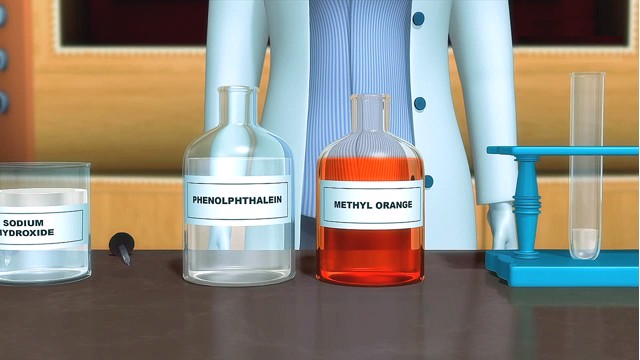Methyl orange is a natural indicator. Methyl orange is an often used pH indicator in titrations because of its apparent and distinct colour shift. It is commonly used in acid titrations because it changes colour at the pH of a mid strength acid. The colour of the solution changes to red when methyl orange is introduced to dilute hydrochloric acid. Methyl orange is one of the most often used pH indicators in titration. The hue of the solution turns red when methyl orange is employed as an indicator with acid.
On the other hand, Phenolphthalein (C20H14O4) is a phthalein-family chemical molecule that is commonly used as an acid-base indicator. Phenolphthalein is colourless below pH 8.5 and becomes crimson to deep red over pH 9.0 when used as a pH indicator. Phenolphthalein is colourless by nature and acts in a different way than litmus paper. It also becomes pink when exposed to an alkaline solution or base. Furthermore, the molecule is colourless in acids but begins to become pink around pH 8.2 and become brilliant purple in strong bases.
Methyl Orange Uses
Methyl orange is a water-soluble azo dye generally recognised as a pH indicator that is widely employed in a variety of sectors, including textile, paper, printing, and food, and is mostly discharged in industrial wastewater. A hydrogen ion is lost from the -NN- bridge between the rings in the basic form of methyl orange, and the electrons that were previously employed to bind the hydrogen neutralise the positive charge on the terminal nitrogen, preventing it from pi-bonding. In an alkaline solution, methyl orange solutions appear yellow.
When it comes into contact with water, methyl orange is a weak acid that breaks down into orange neutral molecules. In acidic conditions, the equilibrium is to the left, and the concentration of neutral molecules is too low to observe the orange colour. Alkaline and neutral water becomes yellow when exposed to methyl orange. The water becomes crimson as soon as it becomes acidic. At pH 4.3, the shift occurs.
Phenolphthalein Universal Indicator
Phenolphthalein is a colourless indicator of acids and bases (pink). Because sodium hydroxide is a base and was in the pitcher at the start, it became pink when added to the phenolphthalein in beakers 2 and 4. Phenolphthalein is colourless in nature but becomes pink when exposed to alkaline solutions. The chemical is colourless over a wide range of acidic pH values, but begins to become pink at pH 8.2 and progresses to a brilliant magenta at pH 10 and higher.
A phenolphthalein indicator is used to do a strong acid-strong base titration. Because it changes colour in a pH range of 8.3 to 10, phenolphthalein was chosen. In basic solutions, it will look pink; in acidic ones, it will seem clear. A substance that changes colour when it comes into contact with an acid or a base. When it comes into contact with anything basic, such as ammonia, it turns purple; when it comes into contact with an acid, such as vinegar, or a neutral material, such as water, it remains colourless.In acid–base titrations, phenolphthalein is frequently employed as an indicator. It turns colourless in acidic solutions and pink in basic solutions for this purpose. It’s a phthalein dye, which means it’s a type of dye.

